The heart of England – the Cromford Canal
August 16th, 2020What is special about British canals?
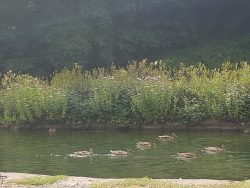
Cromford canal wildlife
Is the charming village of Cromford in Derbyshire in the North of England or the Midlands? Well for me and someone who lives in Nottingham and a forty minute drive away from Cromford it is definitely in the Midlands. In the Canal and River Trust in their brilliant little book ‘coolcanals Walks‘ Cromford Canal is under the heading North of England. In a simple but graphic statement the canal’s landscape sums up what is the heart of England, although equally beguiling canal towpaths can also be found in Wales and Scotland. Visit my blog Walking the Great Glen Way.
There is something very special about the British canal with the backdrop of beautiful woodlands and forgotten flowers, diversity of wildlife and historical buildings dating back centuries. However what distinguishes it from everything else is its ‘slowness’. We walk and cycle along the towpath, paddle our canoe and try to steer our narrow boat and everything slows down. We enter a world that has almost been forgotten today.
Revival of the countryside through the canal
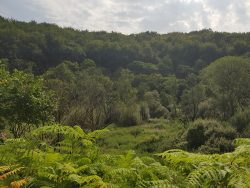
The verdant hillside surrounding Cromford Canal
Yes you have canals in many other countries such as France which have their own sense of beauty. Somehow they are different – usually much wider and without the wildness of the British countryside. In terms of the importance to the economy the British canal was replaced by the railways so it is ironic that like so many other canals in Britain the Cromford Canal is bordered by the local railway running from the village of Whatstandwell to Matlock via Cromford. However the Cromford Canal has reinvented itself and become a centre for tourism bringing much needed money into the local economy. This revival of the countryside through the canal, which is repeated all over Britain, has been achieved without spoiling the peace and quiet of the location.
How to escape the ‘Corona Virus’
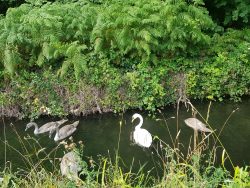
Swans & cygnets go for a paddle
The start of the Cromford Canal is at Cromford Wharf and across the road from the Cromford Mills. I have visited here many times before but the setting of the rolling and verdant woodland hills of the Derbyshire countryside never fail to inspire me. I suspect many people have come here in the midst of ‘Corona Virus’ to escape the fear of the pandemic. They won’t have been disappointed as the tranquility of the canal and its bustling wildlife is always here whatever else is happening in the world. The swans take their cygnets for a trial run through the rushes and compete for space in the water with the ducklings. Hidden away are the water voles but they all seem to happily co-exist. Along the hedgerows you see all sorts of berries growing, including blackberries which are just ready for picking as it is the beginning of August.
A playground for all ages
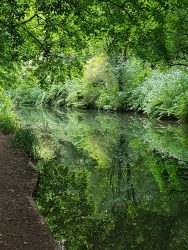
Reflections
A middle aged lady escorts her elderly parents from her car to one of the many canal side picnic tables. This one is under the trees to provide some much needed shade from the mid-day sun. Her mother maneuvers her walking frame with wheels across the grass and the walking frame converts into a comfortable camping chair with the extra comfort of cushions. Younger parents try to keep their little children happy by bribing them with ice creams as they sit at the picnic tables. Nearly all have brought their own picnic food and some even have the luxury of a picnic hamper to add some summer style to the occasion. The local cafe however is also doing quite a brisk trade as the customers avail themselves of the two for one offer subsidized by the government in an attempt to kick start the economy after the malaise of the ‘Corona Virus’. The sunshine has encouraged us to escape the local towns and cities and just sunbathe in the idyllic setting of the Cromford Wharf.
Exploring the canal in a blow up plastic canoe.
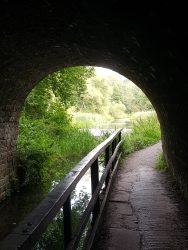
The tunnel at Cromford canal
A local outdoor pursuits organizer has unloaded his van and a row of sturdy canoes equipped with oars and life jackets are lined up on the canal side. More interestingly are two plastic blow up canoes which are being launched onto the water. They safely launch their canoes and start to paddle along with two people in each boat maneuvering the canoes along the water. I ask them where they had purchased their canoes. The surprise answer is £40 from Aldi! When had Aldi started to become a sports equipment supplier? In fact the canoes look quite stylish as they glide along the water and the canoeists although not experts soon master the art of paddling with their oars. Although not always pointing in the right direction they are obviously having good fun despite looking a little nervous. Perhaps this is because they are beginners at this craft or is it the fact they are not equipped with life jackets?
High Peak Junction
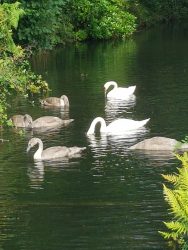
Swan Lake
After you leave Cromford Wharf you can amble along the towpath towards High Peak Junction. This is a distance of about one mile and you can reward yourself with a cup of tea or coffee or treat yourself to an ice cream at the local cafe. Free toilets are also available at this point. You may also like to visit the oldest surviving railway carriages and workshops in the world. This is where the canal meets up with the High Peak Trail which follows the former railway line to Dowlow. This is a steep trail used by both cyclists and walkers.
Just after this point the canal is not passable by canoes and boats but the swans and ducks do manage to wade their way through the weeds and water lilies. There are also benches on the tow path for the walkers to rest on and a bridge for visitors to pass over to the other side of the canal so you can return for part of the way on the opposite side of the canal. It is also possible to explore some of the adjacent woodland via local footpaths that radiate out from the main canal towpath.
Industrial heritage
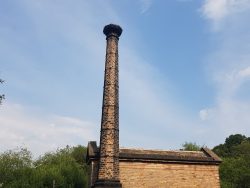
The chimney at Leawood Pump House
Richard Arkwright built Cromford Mill in 1771 and directed the construction of Cromford Canal which was completed in 1794. Richard Arkwright did not see its completion as he died in 1792. The canal was essential for the working of the mill which housed the world’s first water powered cotton spinning frame. Some would say it was the start of the Industrial Revolution.
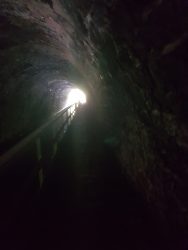
Gregory Tunnel
About half a mile further along from the High Peak Junction on the other side of the canal is to be found the Leawood Pump House. It was built in 1894 to pump water back into the canal which had been displaced by boats using the using the 14 locks from Cromford Canal to the Erewash Canal. Today however the canal finishes at Wigwell Aqueduct. Beyond this point the canal is no longer navigable and much of it is derelict. However recently a planning proposal was submitted to the two local councils to extend the canal beyond this point.
Less than a mile further along you come to Gregory Tunnel which is 76 yards long. Beyond this point eventually leads to a nature reserve. Also nearby is Whatstandwell railway station which you could use to catch a train to return to the station in Cromford.
Holidaying at home
At the time of writing most of us this year have decided to holiday at home following the restrictions imposed by the government to limit the spread of the Corona Virus. The fear of being quarantined following a visit abroad means more folk are exploring the delights of the British countryside. The Cromford Canal is a prime example of what is on offer. It can be combined with a cream tea at the Cromford Wharf and just a few minutes walk away a pint of bitter or glass of wine at a local pub in the village. Hopefully when the impact of the pandemic has receded more overseas visitors will also venture out from the obvious tourist spots in the UK and discover that Cromford Canal really is the ‘Heart of England’.
You may also like to visit ‘Friends of Cromford Canal’ here.
Photographs by Sarah Hacking

